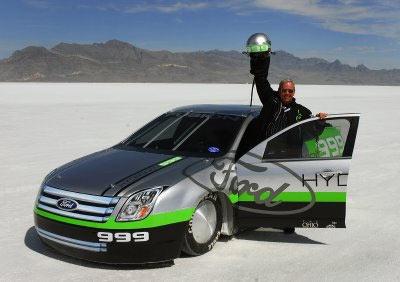Ford Motor Company today became the world's first automaker to set a land speed record for a production-based fuel cell powered car. The Ford Fusion Hydrogren 999 fuel cell car raced to 207.297 mph at the Bonneville Salt Flats in Wendover, Utah to set the record.
The Ford "999" is the world?s first and only production vehicle-based fuel cell race car. It was built in collaboration with Ballard Power Systems, Roush and Ohio State University and is one of two vehicles demonstrating the potential of fuel cell technology. Ford researchers also are supporting student engineers from Ohio State University on its Buckeye Bullet 2, a streamliner-type fuel cell-powered racer attempting 300+ mph.
What we've accomplished is nothing short of an industry first,? said Gerhard Schmidt, vice president, Research & Advanced Engineering for Ford Motor Company. ?No other automaker in the world has come close. We are excited to have accomplished something never before done. We established this project to advance fuel-cell-powered vehicles and to do what has never been done before; and we did it.?
Schmidt said Ford's historic run at Bonneville will further expand the company's technological horizons with fuel cell-powered vehicles, because the use of hydrogen as a fuel could someday play a key role in meeting the energy needs of the transportation sector. The Ford Fusion Hydrogen 999 is Ford?s latest environmental innovation and is another step on the road toward commercially viable hydrogen fuel cell vehicles.
The speed was reached during a run at the Bonneville Nationals, which are being held from Aug. 10-17.
The Ford Fusion Hydrogen 999 land speed record vehicle was designed by Ford engineers and built by Roush in Allen Park, Mich. Ford engineers leveraged the 2004 Buckeye Bullet?s electric motor, while Ballard Power Systems supplied the 400 kW hydrogen fuel cells. Ford retiree Rick Byrnes, a veteran Bonneville racer, piloted the Ford Fusion Hydrogen 999 on its record breaking run.
Ohio State students have designed their streamliner, dubbed Buckeye Bullet 2, from the ground up. Ballard donated the hydrogen fuel cells for Ohio State?s car, Roush its engineering services and Ford has provided overall project coordination and expertise in fuel cell drivetrains.
In 2004, Ohio State students set the unlimited land speed record for an electric vehicle by running 314 mph in the first Buckeye Bullet, dubbed BB1.
The Ford Fusion Hydrogen 999 shows one of the ways Ford is advancing environmental innovation with the goal of offering vehicles with zero impact on the environment. Multiple technologies, including hydrogen fuel cells, hybrids, E85 ethanol, clean diesels, bio-diesels, advanced engine and transmission technologies allow a flexible approach that balances customer needs, environmental impact and shareholder interests.
Ford Motor Company currently has a fleet of 30 hydrogen-powered Focus fuel cell vehicles on the road as part of a worldwide, seven-city program to conduct real world testing of fuel cell technology. The 30-car fleet has accumulated nearly 580,000 miles since its inception in 2005.
Ford also is conducting tests with the world?s first plug-in hybrid electric vehicle, the Ford Edge with HySeries Drive. The Ford Edge with HySeries Drive uses a series electric drivetrain with an onboard hydrogen fuel cell generator to give the vehicle a range of 225 miles with zero emissions.
Ford currently offers gasoline-electric hybrids including the Escape Hybrid and Mercury Mariner Hybrid. The company will also offer hybrid versions of the Ford Fusion and Mercury Milan in 2008. .

